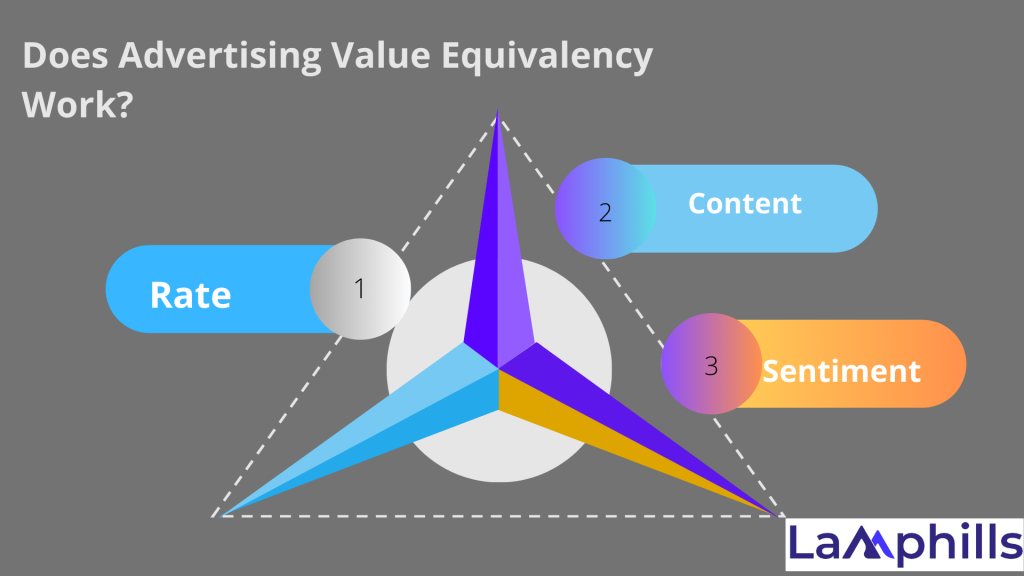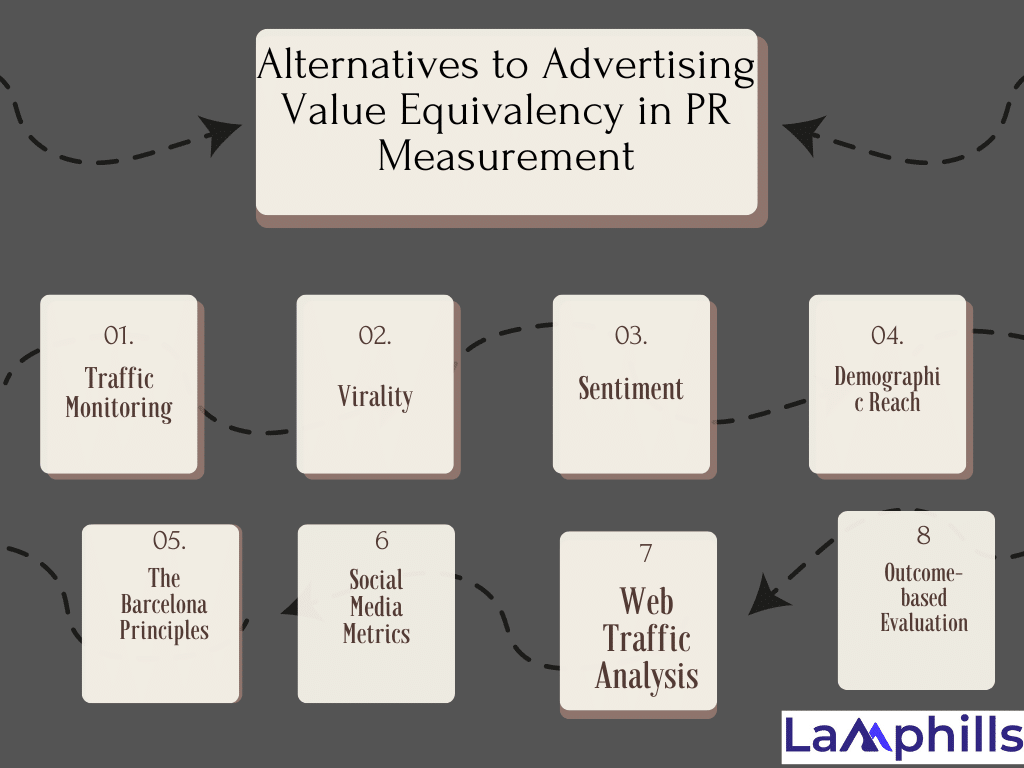Imagine you’re a hardworking public relations executive like me, and your most recent campaign has just concluded. It’s time to ask the unavoidable question: How effective was it? As you browse through press coverage, social media, and blog mentions, you must translate these findings into concrete value. This is when the term Advertising Value Equivalency (AVE) comes into play. AVE, a popular (but contentious) public relations tool, promises to convert your PR efforts into measurable dollars. It’s comparable to an exchange rate between earned media coverage and paid advertising.
However, when measuring the performance of marketing efforts, the numbers might be overwhelming. We’ve all been there: analyzing statistics and attempting to make sense of impressions, clicks, and conversions. But what if there was a method to streamline this procedure and gain a better understanding of your campaign’s impact? To answer the question, this article will explain the complexities of advertising value equivalency, giving you a clearer understanding of its function and application.
Key Takeaways
- Advertising Value Equivalency (AVE) provides a way to quantify the value of earned media by comparing it to the cost of equivalent advertising. This can simplify the process of demonstrating the impact of PR efforts.
- AVE is criticized for its reliance on arbitrary multipliers and inconsistent calculations. The formula often includes subjective adjustments, such as multiplying by factors ranging from 2x to 12x, which lack standardized validation.
- To get a holistic view of a campaign’s effectiveness, AVE should be used in conjunction with other metrics. Hence, combining AVE with tools that measure audience engagement, sentiment analysis, and traffic monitoring can provide a more complete picture.
- Techniques such as sentiment analysis, virality maps, and outcome-based evaluation offer a more nuanced understanding of campaign success. Also, tools like Google Analytics for website traffic and social media analytics platforms for engagement provide valuable data that can complement traditional AVE calculations, leading to more effective and insightful PR strategies.
What is Advertising Value Equivalency (AVE)?

Advertising Value Equivalency, or AVE, is a statistic used to assess the value of media coverage by converting it into comparable advertising costs. It answers the question: “How much would it cost to achieve the same amount of media coverage through paid advertising?“
Assume you recently had a terrific feature piece written about your company in a prominent industry newspaper. AVE allows you to measure such exposure by determining how much you would have had to spend on advertising to achieve the same level of coverage. This can be extremely valuable in determining the media value of your PR activities.
In simple terms, Advertising Value Equivalency (AVE) is a simple calculation that estimates the value of a PR mention by comparing it to the cost of a comparable advertisement. For example, if your PR campaign resulted in a quarter-page article in a printed magazine, you would value the PR mention as the same cost of that ad space.
AVE (Advertising Worth Equivalency) aims to quantify the worth of earned media coverage by estimating the cost of purchasing ad placements of comparable size. Because editorial pieces often attract more attention and trust than bought placements, the fundamental advertising cost is frequently multiplied.
However, the AVE PR statistic, which is out of date, is no longer applicable to modern public relations. It was created as a measurement tool by the public relations business in the 1940s (!) and no longer accurately reflects today’s digital reality. Despite this, it can still provide a fundamental “back of the napkin” estimate to begin evaluating your press mentions.
Understanding Advertising Value Equivalency
AVE is not a new concept. It has been around for decades, originally designed to assess the financial impact of media placements. It has developed over time, but its fundamental goal remains unchanged: to offer a tangible measure of media exposure. Despite its long history, AVE remains a useful tool, particularly when paired with other metrics.
While AVE provides a monetary value for media exposure, it’s important to understand how it compares to other metrics. For example, ROI (Return on Investment) calculates the financial return from a campaign about its cost. Impressions, on the other hand, simply count the number of times your material is viewed.
One of the most significant advantages of AVE is its capacity to assess media impact. For example, if a major business magazine publishes a full-page story about your company, AVE can help you determine the worth of that piece in terms of advertising spend. This can be especially effective when presenting results to clients or top management.
How To Calculate Advertising Value Equivalency
So, how is advertising value equivalency (AVE) calculated? In its most simple calculation, it’s article size x ad rate. You can see where this AVE concept emerged: from traditional newspaper advertising! The AVE definition originally meant an article’s value was its size (a column inch of coverage) x the ad rate (the media outlet’s rate per inch). To illustrate: a 15-inch column x $100 per inch ad rate = $1500 AVE.
With this in mind, PR professionals began multiplying the AVE number by 2x-12x, depending on how much more value they thought should be provided. They also included parameters to account for the entire reach computation. In their quest to discover the true meaning of AVE, they muddied the formula with hypotheticals.
It is no longer necessary to calculate this manually. Keep it simple and let Prowly determine your best PR metrics, as demonstrated in the example report above.
The AVE Formula
But, it’s not quite so straightforward. The ad equivalency calculator should look like this:
AVE = SIZE X RATE
If your article is 10 column inches long, in a paper whose rate is $15 per column inch, your ave is:
AVE = 10 X 15 = $150 AVE
Either result could be accurate. However, without evidence to corroborate the extra variable’s accuracy, there is no obvious response to what is correct.
To make matters even more complicated, some people change the variable to include the reliability of the source. Another ambiguous metric, making it untrustworthy. Furthermore, adding an arbitrary multiple to the Advertising Value Equivalency equation is simply one important aspect that undermines the metric as a whole. It’s only one of the reasons that so many publicists believe that AVE doesn’t offer any significant insights into campaigns
Does Advertising Value Equivalency Work?

For PR measurement, AVE’s don’t work. Like Earned Media Value (EMV) they try to follow a simple formula but include non-formulaic variables. The results rely on too many unsupported numbers. These are important factors they don’t consider.
#1. Rate
Even though it is one of the more trustworthy components of the formula, there are a few factors to consider concerning the rate. Most importantly, where is your rate from? Most outlets will provide a reduction on their advertising rate card to loyal or high-spend clients. Using a discounted advertising rate and then applying the usual rate card rate to PR will make your PR appear to be more effective than it is.
Certain rates don’t exist. A full-page ad on the first page of a newspaper, or in a TV or radio news broadcast, is rarely feasible. However, you may have a PR story in this place. The Advertising Value Equivalency estimate will undoubtedly include an exaggerated rate. Or add an extra variable to represent this, making it difficult to compare it against your advertising costs.
#2. Content
Would you include a competitor’s name in an advertisement, except for comparison? No. Yet, in a news story that could happen, with an article focused more on your competition than yourself. And the AVE formula just ignores it. You and your competitor could calculate the same AVE from the same article even if it focused more on one brand. What’s the value of that?
#3. Sentiment
As the saying goes, “All news is good news.” And, despite numerous examples of PR disasters proving otherwise, AVEs continue to believe it. They do not consider an article’s sentiment. It could be a positive product evaluation, a criticism of a corporation, or a neutral statement. The difference is not measured by the Advertising Value Equivalency calculation. Unless you include an additional variable. Yet another unsubstantiated number.
Criticisms of Advertising Value Equivalency

AVE, while its utility, is not without criticism. Some say that AVE does not take into account the quality of media coverage or the impact on audience behavior. Advertising value equivalency has not always been easy to implement. It has encountered its fair share of volatility in the public relations industry. Critics frequently compare AVE to a mirage in the desert of public relations measurement, attractive but ultimately unreliable. The following are some of the difficulties that industry experts address:
#1. Inaccurate Financial Equivalency
AVE operates on the assumption that the value of editorial coverage is equal to the cost of equivalent advertising space. However, critics argue that editorial content and advertising content carry different weights in the eyes of the audience.
#2. Lack of Qualitative Analysis
AVE is a quantitative indicator that only considers the monetary worth of coverage. However, it fails to include qualitative characteristics such as the tone, context, or attitude of the reporting. For example, a major unfavorable press item may have a high AVE yet has no positive impact on a brand’s image.
#3. Failing to Consider Audience Engagement
In today’s digital age, audience engagement is a critical issue to consider. It must evaluate whether the audience reads or engages with the news, making it a limited measurement tool.
#4. Inconsistency in Calculations
There is no standard procedure for computing AVE, resulting in inconsistencies. Column inches, audience reach, and advertising pricing can greatly differ between media outlets skew AVE calculations.
#5. Rejection by Industry Associations
Several industry bodies, like the International Association for Assessment and Evaluation of Communication (AMEC), have categorically dismissed AVE as a legitimate PR assessment instrument. They claim that PR’s worth goes beyond monetary equivalencies and that depending exclusively on AVE can be deceptive.
As a result, these criticisms drive PR practitioners to seek comprehensive methodologies to quantify PR performance, taking into account both quantitative and qualitative characteristics.
Alternatives to Advertising Value Equivalency in PR Measurement

To gain a more complete picture, consider combining AVE with additional measures. This is because combining it with methods for measuring audience interaction, sentiment, and overall campaign performance can provide a more complete picture. For example, tracking social media mentions and sentiment analysis can help you determine how your target audience is reacting to your media coverage.
Your PR value is unaffected by how much your audience sees or hears it. It’s about the impact it made on them. It is based on actual, tangible numbers acquired from social media analytics, rather than factors.
As the AVE debate continues, various alternative PR measurement approaches have gained traction. Some of these include:
#1. Traffic Monitoring
You can measure the change in traffic on your website. Look for extra engagement, especially from new traffic, and visitor recency. If your PR works, you should see an increase in new visitors and return traffic.
Don’t forget to measure your social media traffic too. So, look for active engagement, where people share or comment on your posts. These people will have taken your message onboard and are helping it diffuse further.
#2. Virality
A Virality Map can show how successful your communications were, by looking at where they shared.
Virality maps help you track where your content is being shared, Talkwalker Media Monitoring
#3. Sentiment
You can measure the emotional impact a campaign has on your audience, with sentiment analysis. This will give you a better idea of whether the PR piece had a positive or negative impact on your brand.
Tracking sentiment over time enables you to see the emotional impact of your campaigns, Talkwalker Media Monitoring
#4. Demographic Reach
With more in-depth analysis, you can gauge more precise demographics of who is engaging with your PR. Therefore, you can measure which markets your campaign is having more impact on.
#5. The Barcelona Principles
This approach to public relations efforts focuses on target setting and measurement. Rather than just evaluating media coverage, these principles urge public relations practitioners to assess the efficacy of their initiatives in reaching their objectives. This gives a complete methodology for assessing PR success beyond monetary value.
#6. Social Media Metrics
In today’s digital world, examining social media data is a useful tool for assessing audience involvement. Likes, shares, comments, and retweets can provide immediate feedback on the effectiveness of a public relations strategy.
#7. Web Traffic Analysis
The extent of audience involvement can be measured by assessing the volume of traffic that public relations initiatives drive to a company’s website. Google Analytics allows you to track website traffic, bounce rates, and other related metrics.
#8. Outcome-Based Evaluation
This method focuses on the results of PR efforts, such as changes in behavior, attitude, or policy. By looking at the result, PR professionals can better understand the real-world impact of their campaigns.
Why is PR value 3 times ad value?
Smart enough to recognize a paid advertisement as a biased angle, viewers, readers, and listeners place confidence in the reports from favored media personalities at a much higher level.
How do you calculate PR value from ad value?
PR value is calculated by multiplying advertising rates by the page percentage your placement covers.
How do you measure the value of advertising?
5 Ways to Accurately Measure Advertising Effectiveness
- Average click-through rate (CTR)
- Conversion rates.
- Cost per Click (CPC)
- Return on Ad Spend (ROAS)
- Return on Investment (ROI)
- Revenue.
How to calculate PR media value?
PR value is calculated by multiplying advertising rates by the page percentage your placement covers. To calculate this measurement, you’d pull the advertising rates from a publication’s media kit (likely available on their website).
Conclusion
And there you have it: a thorough journey through the world of advertising value equivalency. We’ve seen how AVE, like an old friend, has been there for quite some time, assisting us in measuring PR success. However, much like upgrading from a flip phone to a smartphone, we’ve developed newer, more complex techniques to assess our PR impact.
What is the main takeaway? The key is to use the appropriate instrument for the job. Sometimes AVE is enough. However, there are situations when we may need to use heavy guns, such as social media monitoring or outcome-based evaluation.
Remember that the purpose is not merely to collect data, but also to turn it into relevant insights that will inform your campaign strategies. Accept AVE as one part of the puzzle, and you’ll be better equipped to navigate the complex world of media measurement.






